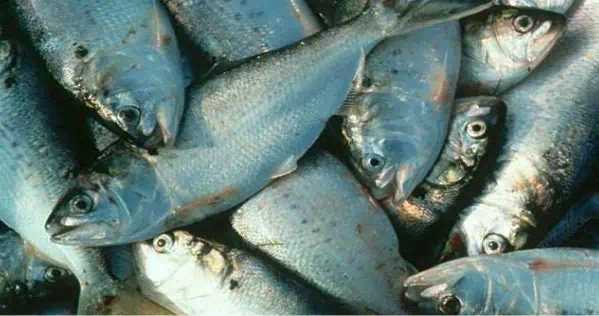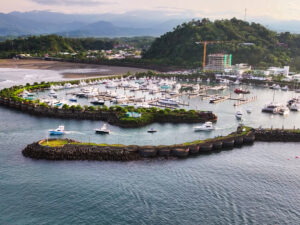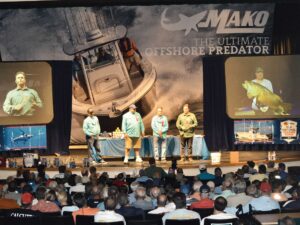
For a small fish, they have caused and continue to cause a great ruckus. Menhaden, or pogies, are again at the center of attention in the Chesapeake Bay. The cacophony is not only about the fish but about the fish catchers and the managers as well.
Industrial Menhaden Operations
The predominant catcher of menhaden is Omega Protein and catch them they do, at the rate of millions and millions of pounds annually. Not only do they catch this important forage fish, they also process it into a range of products used for fish feed to cosmetics.
Make no mistake, this is big business. This is reflected in the fact that up until the last year or so, menhaden were managed by the Virginia General Assembly. All other fish were and are managed by the Virginia Marine Resources Commission (VMRC). It was almost impossible to get any reasoned fisheries management decisions out of the General assembly. Most members do not understand fisheries and the need to make science-based decisions, not political ones.
Since the VMRC took over the management of menhaden, many who have followed this issue were sanguine that better decisions concerning menhaden and its ecological services would be made after several incidents this past summer where net loads of menhaden were dumped due to net failures. These net failures caused the dead fish to cover local beaches with tons and tons of rotting and stinking fish. Those who were impacted said enough. According to the Chesapeake Bay Foundation, “Net spills before busy holiday weekends have hurt the tourism economy in Coastal Virginia communities.”
Menhaden Fishing Prohibitions Fail to Pass
Because of all the bad press around these net spills, the VMRC held a public hearing at its December 6 meeting on a proposal “to modify purse seine area and time prohibitions to include: (i) any waters of the Commonwealth’s Chesapeake Bay and the City of Virginia Beach within one nautical mile from the mean low water line; (ii) one-half nautical mile on either side of the Chesapeake Bay Bridge Tunnel; and (iii) the Commonwealth’s waters of the Chesapeake Bay the Thursday prior to, and through Memorial Day; July 1 through July 7; and the Thursday prior to, and through Labor Day.” This action would have codified these restrictions to the fishery which were focused on minimizing any possible net spills. They were not focused on restricting the overall catch quota.
The VMRC instead approved an alternative, “To create a Memorandum of Understanding (MOU) of the following: The fishery agrees to not fish in the State territorial waters inside of the Chesapeake Bay on Sat-Mon of Memorial Day and Labor Day. The fishery agrees to not fish in the State Territorial waters inside of the Chesapeake Bay on July 4th and the federally recognized Holiday of the week. The fishery agrees to not fish in the State territorial waters inside of the Chesapeake Bay on all Saturdays and Sundays between Memorial Day and Labor Day. The fishery agrees not to fish within 1/2 mile of the Chesapeake Bay Bridge Tunnel as a measure of cooperation to minimize user conflicts with the recreational angling community. The fishery agrees to work collaboratively with the Governor’s Office and General Assembly members to address geographic buffer along the densely populated areas of the Eastern Shore of Virginia, in the Chesapeake Bay and the Virginia Beach region.”
Public Outcry
Some folks are upset at this decision coming out of the VMRC. When you compare the two alternatives, they are generally the same. In fact, the MOU is more restrictive in some ways. The big difference is that an MOU is not codified regulation. Having recently covered the subject, we know how well the menhaden seiners in the Gulf of Mexico adhered to agreements. Does this MOU simply give them too much wiggle room and no real penalties if they don’t comply?
A little earlier in the year, a bill was introduced by State Delegate Tim Anderson for the next session of the Virginia General Assembly to place a two year moratorium on Atlantic menhaden reduction fishing in Virginia’s portion of the Chesapeake Bay. We will see if this recent action by the VMRC will give the bill traction or take the air out of its tires. Here are plenty of folks who hope for the former.
In the meantime, Chris Moore, Senior Scientist of the Chesapeake Bay Foundation vows that “We’ll continue to advocate for protecting the enormous ecological value of Virginia’s menhaden population and commonsense solutions that reduce conflicts between Omega Protein’s fishing fleet and anglers, boaters, beachgoers, and Virginia’s tourism economy.”









